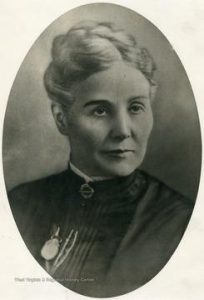If there is a single fact that West Virginia students retain from prepping for the Golden Horseshoe exam it is that Mother’s Day began in West Virginia.
Forgotten, however, may be the circumstances.
Anna Maria Jarvis wanted to honor her mother and social activist, Ann Maria Jarvis (shown in the photo). The Jarvis family lived in Grafton, West Virginia, where Anna Jarvis’ father was a Methodist minister. Concerned about the unsanitary living conditions in Appalachian homes, in 1858 Jarvis’ mother organized Mother’s Day Work Clubs and invited doctors to meet with local women to talk about hygiene practices that could keep children healthy. During the Civil War, she pivoted the clubs’ mission to become a neutral aid group to provide care and comfort to soldiers, regardless of which side they fought. At the end of the war, Jarvis organized Mothers’ Friendship Day to reunite Union and Confederate veterans.
After attending Augusta Female Academy (now Mary Baldwin College) and teaching school in West Virginia, Anna Jarvis moved to Philadelphia where she became an advertising copywriter. In 1908, she sent 500 white carnations to the Andrews Methodist Church in Grafton in honor of her mother, and the locals held the first Mother’s Day event on May 10, 1908. Two years later, West Virginia designated it a state holiday. Jarvis organized the Mother’s Day International Association and pressed for a national Mother’s Day. In 1914, President Woodrow Wilson signed the law that made Mother’s Day a legal holiday.
Anna Jarvis, who never had children, died blind, demented, and penniless in a Pennsylvania sanatorium in 1948. She and her mother are buried next to each other.
Photo: Courtesy of West Virginia University West Virginia & Regional History Center.
Sources: Time, History of American Women, Hinton Daily News, www.military.com.



